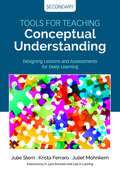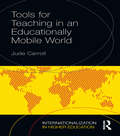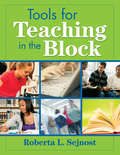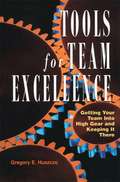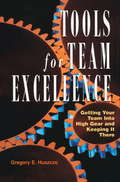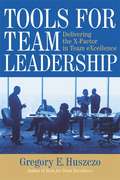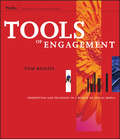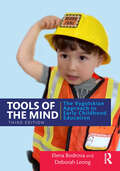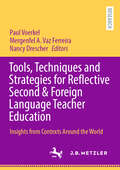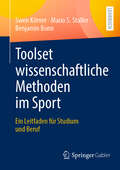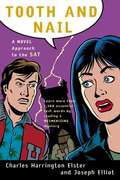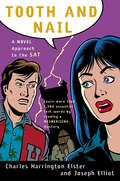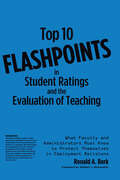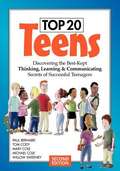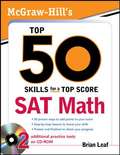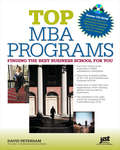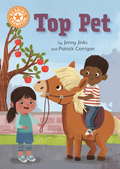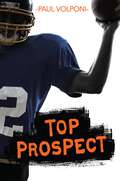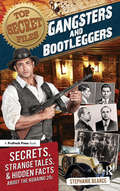- Table View
- List View
Tools for Teaching Conceptual Understanding, Secondary: Designing Lessons and Assessments for Deep Learning (Corwin Teaching Essentials)
by Julie Stern Krista Ferraro Juliet MohnkernStudents become experts and innovators through Concept-Based teaching Innovators don’t invent without understanding how the world works. With this foundation, they apply conceptual understanding to solve problems. We want students to not only retain ideas, but relate them to other things they encounter, using each new situation to add nuance and sophistication to their thinking. Discover how to help learners uncover conceptual relationships and transfer them to new situations. Teachers will learn: Strategies for introducing conceptual learning to students Four lesson frameworks to help students uncover conceptual relationships How to assess conceptual understanding, and How to differentiate concept-based instruction
Tools for Teaching in an Educationally Mobile World (Internationalization in Higher Education Series)
by Jude CarrollTools for Teaching in an Educationally Mobile World examines the challenges that undergraduate and postgraduate teachers often encounter when working with students from different national and cultural backgrounds. It focuses on the consequences for interactive teaching and for course design in a world where students, ideas and courses are mobile, using examples and experiences from a wide range of disciplines and national contexts. It not only considers Anglophone countries, including the USA, Canada, the UK, Australia and New Zealand, but also the use of English as a language of instruction in countries where neither teachers nor students are native English speakers. This book offers ideas for adjusting and adapting teaching approaches for culturally and linguistically diverse student groups. Students may cross national boundaries to seek accreditation, or the courses may be ‘transnational’, being designed in one country and delivered in another using local as well as ‘fly-in’ faculty. It draws upon growing good practice recommendations using tried and tested methods alongside the extensive and varied experience of the author. The book is structured around a selection of the most common issues and statements of belief held by educators, with key topics including: the impact of educational mobility on teaching and learning; teachers as mediators between academic cultural differences; learning and teaching in English; inclusive teaching and learning; encouraging student participation; assessing diverse students. With a wealth of practical tips and tools that help deal with these issues, this book will be of value to any educator working with students from culturally and linguistically diverse backgrounds. It will also interest those involved in the design of curriculum and pedagogy.
Tools for Teaching in the Block
by Roberta L. SejnostEffectively use the extended class period to enhance student achievement! Take advantage of block scheduling with this book's four-phase lesson planning framework and numerous instructional strategies to build higher-level thinking skills and increase student learning. Teachers in any subject area can use practical, research-based methods and tools such as cooperative learning, quality questioning, and graphic organizers to reach adolescents. Each chapter includes reproducible blackline masters for classroom use, plus activities for: Preparing students for learning by focusing on prior knowledge, reading, writing, and critical thinking Helping students actively interact with and process what they have learned Clarifying, reinforcing, and extending learning
Tools for Team Excellence: Getting Your Team into High Gear and Keeping it There
by Gregory E. HuszczoIn Tools for Team Excellence, author Gregory Huszczo describes how readers can foster the seven key components of effective teams: specific targets, appropriate talent, clear responsibilities, efficient procedures, constructive relationships, active reinforcement, and diplomatic ties with other parts of the organization. Packed with practical team training exercises, this volume provides comprehensive information on building, assessing, and improving team performance. Huszczo examines each component and provides the strategies and techniques needed to ensure team and organizational effectiveness.
Tools for Team Excellence: Getting Your Team into High Gear and Keeping it There
by Gregory HuszczoTeam development is a process, not a program. There is always room for improvement, and in today's competitive marketplace, if you don't continue to improve, you won't survive. Going beyond either the trendy fads or philosophical approaches outlined in most current management literature, Tools for Team Excellence provides a candid look at team based management and a host of hands-on techniques for building, assessing, and improving team performance. Exercises and worksheets, questionnaires and assessment techniques, problem-solving guidelines and troubleshooting tips make this book immediately practical and valuable to team members, managers, consultants, and leaders. Drawn from the author's direct experience in over thirty years of working with teams, Tools for Team Excellence describes and elaborates on seven key components for creating effective teams. It shows how to address each of these key components, ensuring effective teams that will contribute to the success of an organization.
Tools for Team Leadership: Delivering the X-Factor in Team Excellence
by Gregory E. HuszczoThis self-study training guide puts the power of participative leadership into the hands of every manager, trainer, consultant, and team member struggling to help teams succeed. Packed with more than eighty new and field-tested tools, Tools for Team Leadership solves the mystery of why some teams-regardless of talent-succeed while others fail and delivers everything you need to master the "X-factor" skills of team leadership.
Tools of Engagement
by Tom BunzelTrainers, consultants, HR professionals need a resource for helping them apply social media technology to their meetings and training sessions. This resource shows how to get an online meeting scheduled, plan its contents, rehearse, and prepare, deliver meaningful content over the web, and follow up with a strategic plan to take full advantage of all aspects of the event going forward. It also covers continuing the dialog with other online technologies and shows how mashing and social networking can help train and teach. The book also includes Premium Content.
Tools of the Mind: The Vygotskian Approach to Early Childhood Education
by Elena Bodrova Deborah LeongNow in its third edition, this classic text remains the seminal resource for in-depth information about major concepts and principles of the cultural-historical theory developed by Lev Vygotsky, his students, and colleagues, as well as three generations of neo-Vygotskian scholars in Russia and the West. Featuring two new chapters on brain development and scaffolding in the zone of proximal development, as well as additional content on technology, dual language learners, and students with disabilities, this new edition provides the latest research evidence supporting the basics of the cultural-historical approach alongside Vygotskian-based practical implications. With concrete explanations and strategies on how to scaffold young children’s learning and development, this book is essential reading for students of early childhood theory and development.
Tools, Techniques and Strategies for Reflective Second & Foreign Language Teacher Education: Insights from Contexts Around the World
by Paul Voerkel Mergenfel A. Vaz Ferreira Nancy DrescherEssential questions about the skills teachers need for effective classroom practice have raised by researchers such as Shulman, Schön, Altrichter & Posch and Hattie, and discussions still continue. In this context, the anthology combines theoretical studies and practical insights about Reflection from foreign and second language teacher education and professional development. It includes examples of reflective tools, techniques and strategies that can help teachers to (re)think their practices and ensure the quality of their everyday work.
Toolset wissenschaftliche Methoden im Sport: Ein Leitfaden für Studium und Beruf
by Swen Körner Mario Staller Benjamin BonnDieses Buch zeigt Dir, wie wissenschaftliche Skills Dein Denken, Arbeiten, Deine Kommunikation, Deine Trainings und Deine Coachings erfolgreicher machen. Für Sportstudierende bietet das Werk eine Schritt-für-Schritt-Anleitung für einen erfolgreichen Abschluss des Studiums. Für Berufspraktiker, die Menschen im Sport begleiten, bietet das Buch zahlreiche Anregungen, wie sie forschungsorientiert unterrichten, trainieren und coachen können.Die Autoren nehmen mit klarer Struktur, flüssiger Schreibweise und konkretem Alltags-Nutzen der vermuteten Schwere des Themas jeglichen Schrecken. Es macht große Freude, sich mit diesem Buch in die wissenschaftlichen Skills einzuarbeiten. Zum Abschluss bietet das Werk 26 wissenschaftliche Tools und ein ausführliches Glossar – was das Buch auch zum täglichen nützlichen Nachschlagewerk macht.Aus dem InhaltEinleitung: Die besondere Rolle des Sports in unserer Gesellschaft; der positive Beitrag von wissenschaftlichen Skills im Sport-Studium und BerufWissenschaft im Sportstudium: Hausarbeiten; Vortrag und Präsentation; mündliche Prüfung; Klausuren schreiben; Bachelor- und Masterarbeiten professionell schreibenWissenschaftlichkeit im Beruf: forschungsbasiert unterrichten (Schule); forschungsbasiert coachen (Gesundheitssystem, Leistungs- und Breitensport); an Hochschulen lehren & forschen, professionell über Sport berichten (Journalismus und Medien); Sport professionell managen„Help Yourself“: wissenschaftliche Tools von A bis Z, Glossar von A bis Z
Tooth and Nail: A Novel Approach to the New SAT
by Charles Harrington Elster Joseph ElliotThis book is an SAT vocabulary-building program in the lively form of a mystery novel. Now students who take the Scholastic Assessment Test can learn more than 1,200 SAT words, improve reading comprehension, and enjoy a good story all at the same time. The book includes exercises, and a glossary with page references.
Tooth and Nail: A Novel Approach to the SAT
by Charles Harrington Elster Joseph ElliotAn SAT and ACT vocabulary-building program in the lively form of a mystery novel. Now students who take these entrance exams can learn more than 1,300 vocabulary words, improve reading comprehension, and enjoy a good story all at the same time. Includes exercises, glossary with page references.
Top 10 Flashpoints in Student Ratings and the Evaluation of Teaching: What Faculty and Administrators Must Know to Protect Themselves in Employment Decisions
by Ronald A. BerkATTENTION: ALL FACULTY & ADMINISTRATORS“Another book on student ratings? Are you kidding me?” “Nope, but this one is REALLY different.” Another review of the research or step-by-step on how to develop and interpret rating scales? NOT! (Berk did that with Thirteen Strategies) Designed to solve YOUR problems, conflicts, and confusion about how to evaluate teaching. Written expressly for YOU with Berk’s signature sense of humor.FLASHPOINT: a critical stage in a process, trouble spot, contentious issue, volatile hot button, or lowest temperature at which a flammable liquid will give off enough vapor to igniteThe “flashpoints” covered are the topics that pop up the most frequently and heatedly on listservs, blogs, and the literature. Each flashpoint is defined succinctly, options are presented, and then evidence-based recommendations for concrete action steps are proffered in an effort to stop the popping.The recommendations are grounded in psychometric, professional, and legal standards. The last-named, in particular, can protect you from costly litigation. If you hire, promote, demote, and fire full- and part-time faculty based on student ratings and other measures, then you are vulnerable to violations of federal anti-discrimination laws. Several flashpoints address procedures you can take to stay out of court. If you are a faculty member, you need to know whether your institution’s measures of teaching are appropriate and defensible, and what you should do if they are not.Four sample “flashpoints” and solutions:• Use of global items for summative decisions. SOLUTION: “Cease & desist” and use scale and subscale ratings• Low response rate in online administrations. SOLUTION: 20 strategies to increase rates• Scales to evaluate online and blended/hybrid courses. SOLUTION: 7 strategies are suggested and evaluated • Use of ratings for contract renewal, pay raise, teaching awards, and promotion and tenure. SOLUTION: Applying 80/20 rule for adverse impact to avoid lawsuits related to unequal pay, gender, race, ethnicity, and age discrimination
Top 20 Teens: Discovering the Best-Kept Thinking, Learning and Communicating Secrets of Successful Teenagers (2nd Edition)
by Michael Cole Paul Bernabei Tom Cody Mary Cole Willow SweeneyApplication of the principles discussed in this book could result in you making a positive difference in your life and the lives of others! <p>All teens have the potential to become difference makers, to create meaningful and successful experiences for themselves and others However, not all teens know they have this power. That's where this book comes in. <p>Developed by a team of students, parents and educators, Top 20 Teens presents the Thinking, Learning and Communicating skills of the Top 20, the difference makers. By applying these skills in your personal relationships and school experiences, you can become the author of your life's story rather than just a character in it.
Top 50 Skills for a Top Score: SAT Math
by Brian LeafWe want to help you succeed on the math portion of the SAT* "What a surprise, what a relief! An SAT guide that actually meets you where you are, talks to you with wit and compassion, and clears away the panic of test taking. "-- Rebecca Pepper Sinkler, former Editor, The New York Times Book Review We've put all of our proven expertise into McGraw-Hill's Top 50 Skills for a Top Score. With this book, you'll master the essential skills identified by a prominent SAT instructor and add points to your score. You'll get focused instruction on these crucial skills, helpful exercises, pre- and posttests to check your weaknesses and progress, and two additional tests on the accompanying CD-ROM. With McGraw-Hill's Top Skills for a Top Score: SAT Math, we'll guide you step by step through your preparation and give you the tools you need to succeed. Inside you'll find: 50 essential skills with step-by-step sample exercises A pretest to identify your weaknesses and a posttest to track your progress Two additional tests on CD-ROM Strategies to help you answer every type of SAT math item
Top Class English FAL Grade 9 Learner's Book: UBC contracted
by Debbie Martin Bobby Keal Cathy Harris Rona StubbingsYour Shuters Top Class English First Additional Language Grade 9 Learner's Book: • covers all the work you are expected to learn in this Grade • is written in simple language to help you learn and understand your work easily • has pictures and other illustrations to help you understand your work better • explains new and difficult words on the pages where these words are used • has clear cross references to the Core Reader Available components Shuters Top Class English First Additional Language Grade 9 Learner's Book Shuters Top Class English First Additional Language Grade 9 Core Reader Shuters Top Class English First Additional Language Grade 9 Teacher's Guide
Top Class English FAL Learner's Book Grade 6: UBC contracted
by P. John K. Bisschoff V. Mottram S. Boucher C. JacskonYour Shuters Top Class English First Additional Language Grade 6 Learner's Book: • covers all the work you are expected to learn in this Grade • is written in simple language to help you learn and understand your work easily • has pictures and other illustrations to help you understand your work better • explains new and difficult words on the pages where these words are used
Top Class English FAL Learner's Book Grade 6: UBC uncontracted
by P. John K. Bisschoff V. Mottram S. Boucher C. JacskonYour Shuters Top Class English First Additional Language Grade 6 Learner's Book: • covers all the work you are expected to learn in this Grade • is written in simple language to help you learn and understand your work easily • has pictures and other illustrations to help you understand your work better • explains new and difficult words on the pages where these words are used.
Top Class English FAL Reader Grade 6: UBC contracted
by D. Anderson B. Krone J. Morsbach J. BlochYour Shuters Top Class English First Additional Language Grade 6 Reader makes learning fun. It is filled with: • Stories • Poems • Plays • Information and other texts • Pictures and activities Available components Shuters Top Class English First Additional Language Grade 6 Learner's Book Shuters Top Class English First Additional Language Grade 6 Reader Shuters Top Class English First Additional Language Grade 6 Teacher's Resource Pack
Top Class English FAL Reader Grade 6: UBC uncontracted
by D. Anderson B. Krone J. Morsbach J. BlochYour Shuters Top Class English First Additional Language Grade 6 Reader makes learning fun. It is filled with: • Stories • Poems • Plays • Information and other texts • Pictures and activities Available components Shuters Top Class English First Additional Language Grade 6 Learner's Book Shuters Top Class English First Additional Language Grade 6 Reader Shuters Top Class English First Additional Language Grade 6 Teacher's Resource Pack
Top MBA Programs
by David PetersamHelps readers focus on the overlooked issue of business school "fit," create a personal ranking of their best-fit schools, and prepare applications that tell admissions committees why they're the right match for their programs.
Top Pet: Independent Reading Orange 6 (Reading Champion #544)
by Jenny JinksWhen their teacher announces Pet Week at school, the children are excited to show off their pets to their classmates! Who will be voted 'Top Pet' by the end of the week? Will it be the cute puppy, the amazing pony ... or something even more exciting? Reading Champion offers independent reading books for children to practise and reinforce their developing reading skills.Fantastic, original stories are accompanied by engaging artwork and a reading activity. Each book has been carefully graded so that it can be matched to a child's reading ability, encouraging reading for pleasure.
Top Prospect
by Paul VolponiTravis Gardner lives to play quarterback. He's a standout QB by middle school, and he's prepared to put everything he has into the game. Then Gainesville University's head coach makes Travis a promise: Travis will have a place on the team, and a scholarship to go with it. He just has to get through high school first. As Travis starts ninth grade, he'll have to earn his teammates' trust and dodge opponents aiming to sack the star quarterback. But his biggest challenge might be staying focused in the face of sudden fame. Because now the pressure is on, and Travis has to prove himself with every pass. "Travis' love for the game . . . seems absolutely authentic. This engaging read will resonate with middle schoolers, especially aspiring athletes."—Booklist
Top Score Writing: Passages
by Lisa Collum8th Grade Student Workbook for writing Passages, preparing for the State Writing Assessment.
Top Secret Files: Gangsters and Bootleggers, Secrets, Strange Tales, and Hidden Facts About the Roaring 20s (Top Secret Files Of History Ser. #0)
by Stephanie BearceBlind pigs, speakeasies, coffin varnish, and tarantula juice were all a part of the Roaring 20s. Making alcohol illegal didn't get rid of bars and taverns or crime bosses: They just went underground. Secret joints were in almost every large city and could be entered if you knew the right code words. Discover the crazy language and secret codes of the Prohibition Era—why you should mind your beeswax and watch out for the gumshoe talking to the fuzz or you might end up in the cooler! It's all part of the true stories from the Top Secret Files: Gangsters and Bootleggers. Take a look if you dare, but be careful! Some secrets are meant to stay hidden . . . Ages 9-12
